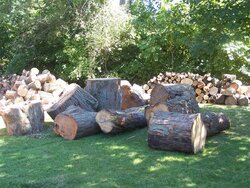Some of you may remember my initial post about a local tree service company dropping off some massive red oak rounds.
The wife asked if I could cut an 8" cookie from one of the red oak rounds (50" diameter) and attach some smaller rounds (10") for legs. Now I'm all for making the wife happy. But I don't want to be wasting my wood either....
I don't know jack about the preparation involved for furniture fabrication. What would I have do? Is it a costly process?
If was to attempt this blindly I would cut the cookie and let it sit in my shed for 2 years before I did anything else. If it cracked too badly, I would split it up and use it for it's original intention.
The wife asked if I could cut an 8" cookie from one of the red oak rounds (50" diameter) and attach some smaller rounds (10") for legs. Now I'm all for making the wife happy. But I don't want to be wasting my wood either....
I don't know jack about the preparation involved for furniture fabrication. What would I have do? Is it a costly process?
If was to attempt this blindly I would cut the cookie and let it sit in my shed for 2 years before I did anything else. If it cracked too badly, I would split it up and use it for it's original intention.


